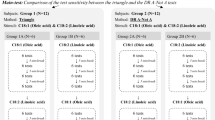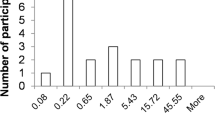Abstract
Retronasal discrimination between vapor-phase fatty acids was tested in 40 participants. Linoleic, oleic, or stearic fatty acids were used in stimulus delivery containers (SDC) at concentrations previously determined to be detectable when presented vapor phase retronasally (Bolton and Halpern in Chem Senses 35:229–238, 2010). For each of these 18-carbon fatty acids, participants received, retronasally, 5 SDC on 2 trials, with 4 of the containers holding, in random order, 1 fatty acid, and the 5th container, a different fatty acid. In addition, for a “negative control”, on two trials, participants received very dilute linoleic acid (0.005%) versus mineral oil. For all trials, the task was to select the one different SDC. It was found that the one different SDC was selected on 83% of the stearic versus linoleic acid trials, 75% of stearic versus oleic acid trials, 58% of linoleic versus oleic acid trials, and 12% of very dilute linoleic acid versus mineral oil trials. An ANOVA found a difference between these distributions, p < 0.0001. Seventy percent of participants discriminated, i.e., selected the 1 different SDC on both trials (chance p = 0.04) between stearic and linoleic acids, 65% discriminated between stearic and oleic acids, and 38% discriminated between linoleic and oleic acids. No participants discriminated on “negative control” trials. These data suggest that retronasal vapor-phase stearic fatty acid is discriminated from vapor-phase linoleic or oleic fatty acids and that oleic and linoleic fatty acids, at concentrations known to be detectable, are discriminated from each other by a substantial minority of participants.


Similar content being viewed by others
References
Bolton B, Halpern BP (2010) Orthonasal and retronasal but not oral-cavity-only discrimination of vapor-phase fatty acids. Chem Senses 35:229–238
Cain WS, Wijk RA, Jalowayski AA, Pilla Caminha G, Schmidt R (2005) Odor and chemesthesis from brief exposures to TXIB. Indoor Air 15:445–457
Cain WS, Lee N-S, Wise PM, Roland Schmidt R, Ahn B-H, Cometto-Muñiz JE (2006) Chemesthesis from volatile organic compounds: psychophysical and neural responses. Physiol Behav 88:317–324
Chalè-Rush A, Burgess JR, Mattes RD (2007) Multiple routes of chemosensitivity to free fatty acids in humans. Am J Physiol Gastrointest Liver Physiol 292:G1206–G1212
Chen V, Halpern BP (2008) Retronasal but not oral-cavity-only identification of “purely olfactory” odorants. Chem Senses 33:107–118
Chow CK (2008) Fatty acids in foods and their health implications, 3rd edn. CRC, Boca Raton
Food Chemicals Codex (2011) 7, through first supplement http://online.foSDChemicalscodex.org/online/login. Accessed 15 Jan 2011
Frasnelli J, Hummel T (2005) Intranasal trigeminal thresholds in healthy subjects. Environ Toxicol Pharmacol 19:575–580
Gunstone FD (2002) Food applications of lipids. Chapter 24. In: Akon CC, Min DB (eds) Food lipids: chemistry, nutrition, and biotechnology, 2nd edn. Marcel Dekker, New York
Halpern BP (2004) When are oral cavity odorants available for retronasal olfaction? In: Deibler KD, Delwiche J (eds) Handbook of flavor characterization: sensory analysis, chemistry, and physiology. Marcel Dekker, New York
Macmillan NA (2002) Signal detection theory. In: Pashler H, Wixted J (eds) Steven’s handbook of experimental psychology. Methodology in experimental psychology, vol 4, 3rd edn. Wiley, New York
Mattes RD (2009) Is there a fatty acid taste? Ann Rev Nutr 29:305–327
McGee H (2004) On food and cooking. Scribner, New York
Miettinen S-M (2004) Instrumentally measured release and human perception of aroma compounds from foods and model systems differing in fat content. EKT series 1319. Ph.D. thesis, Department of Applied Chemistry and Microbiology and Department of Food Technology, University of Helsinki
Miettinen S-M, Hyvönen L, Linforth RST, Taylor AJ, Tuorila H (2004) Temporal aroma delivery from milk systems containing 0−5% added fat, observed by free choice profiling, time intensity, and atmospheric pressure chemical ionization–mass spectrometry techniques. J Agric Food Chem 52(26):8111–8118
O’Keefe SF (2002) Nomenclature and classification of lipids. Chapter 1. In: Akon CC, Min DB (eds) Food lipids: chemistry, nutrition, and biotechnology, 2nd edn. Marcel Dekker, New York
Olzak LA, Thomas JP (1986) Seeing spatial patterns. In: Boff KR, Kaufmann L, Thomas JP (eds) Handbook of perception and human performance. Sensory processes and perception, vol I. Wiley, New York
Parikh V, Lee-Lim AP, Halpern BP (2009) Retronasal and oral-cavity-only identifications of air-phase trigeminal stimuli. Chemo Percept 2(1):9–24
Roberts DD, Acree TE (1995) Simulation of retronasal aroma using a modified headspace technique: investigating the effects of saliva, temperature, shearing, and oil on flavor release. J Agric Food Chem 43:2179–2186
Ruijschop RM, Boelrijk AE, de Graaf C, Westerterp-Plantenga MS (2009a) Retronasal aroma release and satiation: a review. J Agric Food Chem 57(21):9888–9894
Ruijschop RMAJ, Burgering MJM, Jacobs MA, Boelrijk AEM (2009b) Retro-nasal aroma release depends on both subject and product differences: a link to food intake regulation? Chem Senses 34(5):395–403
Schäfer A, Aaslyng MD (2006) The effect of fatty acid precursors on the volatile flavour of pork. Dev Food Sci 43:371–374
Sigma-Aldrich® Product Portfolio (2010) http://www.sigmaaldrich.com/technical-service-home/product-portfolio.html. Accessed 22 Jan 2011
Simopoulos AP (2008) The importance of the omega-6/omega-3 fatty acid ratio in cardiovascular disease and other chronic diseases. Exp Biol Med 233(6):674–688
Stephenson D, Halpern BP (2009) No oral-cavity-only discrimination of purely olfactory odorants. Chem Senses 34:121–126
Taylor AJ (1996) Volatile flavor release from foods during eating. Crit Rev Food Sci Nutr 26:765–784
Warner K, Orr R, Glynn M (1997) Effect of fatty acid composition of oils on flavor and stability of fried foods. J Am Oil Chem Soc 74(4):347–356
Weiss TJ (1983) Food oils and their uses, 2nd edn. AVI, Westport
Wysocki CJ, Wise P (2004) Methods, approaches, and caveats for functionally evaluating olfaction and chemesthesis. In: Deibler KD, Delwiche J (eds) Handbook of flavor characterization. Sensory analysis, chemistry, and physiology. Marcel Dekker, New York, pp 1–40
Yackinous C, Guinard J-X (2000) Flavor manipulation can enhance the impression of fat in some foods. J Food Sci 65:909–914
Acknowledgments
We thank Christopher Chen and Robert A. Raguso for comments on a previous version of this manuscript. This research was supported by a Susan Linn Sage Professorship at Cornell-Ithaca.
Author information
Authors and Affiliations
Corresponding author
Rights and permissions
About this article
Cite this article
Kallas, O., Halpern, B.P. Retronasal Discrimination Between Vapor-Phase Long-Chain, Aliphatic Fatty Acids. Chem. Percept. 4, 16–24 (2011). https://doi.org/10.1007/s12078-011-9085-5
Received:
Accepted:
Published:
Issue Date:
DOI: https://doi.org/10.1007/s12078-011-9085-5




